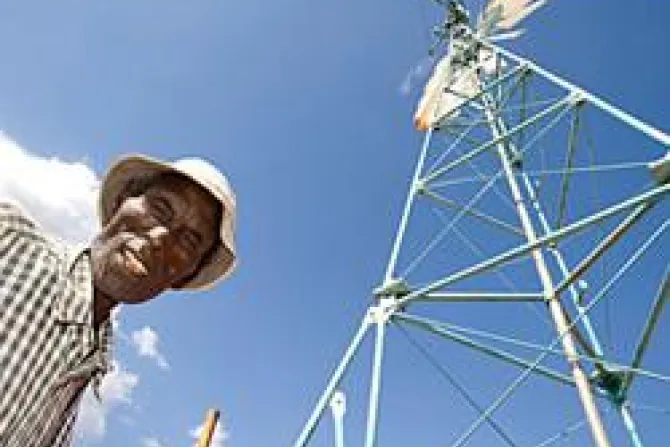Baltimore, Md., Sep 27, 2011 / 22:56 pm
Mixed with the braying of livestock and the welcome laughter of children, a new sound swirls above the village of Nakupurat in Kenya these days. It is the steady creaking of a windmill. For villager Ekiru Ewoi and the 2,000 residents here, it is a sound that reminds them daily that the hard days of thirst have passed.
"When the windmill was broken, we were going to the river," Ekiru says. "That took the whole day, from morning to evening, to get water."
Like many in Kenya's Isiolo District today, the villagers of Nakupurat have been hit by the drought gripping the country. More than three million people across Kenya are directly affected, many of them pastoralists like Ekiru whose lives depend on the grasses their livestock need to stay healthy.
Staying alive became more difficult in 2009, when the windmill that pumps water from a well in Nakupurat broke. With the next closest water source miles away in the muddy waters of the Ewaso Nyiro River, the effect on Nakupurat was catastrophic. Young men herded their livestock to greener pastures and the village school closed, forcing children to walk nearly seven miles each way to attend class at a neighboring school. Elders like Ekiru, too old to join the young men in their search for forage, struggled each day to make the arduous journey to the river.
"I used to take the livestock to the river myself," Ekiru says. "I was becoming very tired on those trips, and I was suffering from hunger and joint pain."
But in July 2011, the blades of Nakupurat's windmill began spinning again, thanks to Catholic Relief Services and its partner agency, the Vicariate Apostolic of Isiolo. Together, they're rehabilitating 27 water sources across the Isiolo District. It's all part of the 6-month Isiolo Emergency Response project. Through it, the relief service is rehabilitating sand dams, shallow wells and the Nakupurat windmill as a way to provide immediate relief for Kenyans affected by drought.
For the villagers of Nakupurat, the effect has been dramatic. With clean water readily available, villagers wash more often and report that ailments common in areas of drought, such as diarrhea and worms, are greatly reduced. For the livestock on which these pastoralists depend, easy access to water has had an equally dramatic effect.
"Now that we are not going far away to get water, we are just able to stay near here," Ekiru says. "The livestock were getting tired and weak when they were walking long distances. But now we see they are growing strong."
He used to spend eight hours each day herding his goats to water. Now, Ekiru says he has an easy 30-minute walk. With his free time, Ekiru volunteers to look after the windmill and the attached distribution points for washing, drinking and watering livestock. Through the project, Catholic Relief Services will soon begin educating villagers on how to set up a fund to maintain the windmill.
Meanwhile, Ekiru and the villagers of Nakupurat are facing the dry season with a grim acceptance, tempered by the faith they have in their newly functional windmill. Looking out over the parched landscape around the village, Ekiru offers to the small group gathered to fetch water a simple lesson on local history.
"I have not seen drought like this for years," Ekiru says.
David Snyder is a photojournalist based in Baltimore, Maryland. Visit Catholic Relief Services at: http://crs.org/


